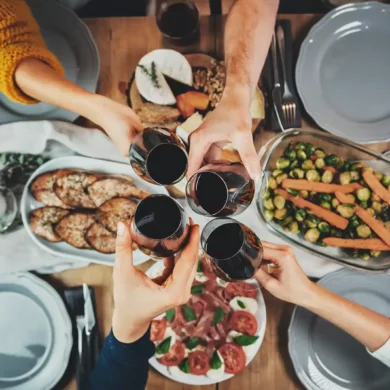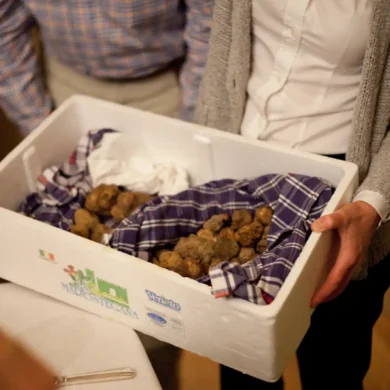“No safe level of alcohol.” For people in the wine industry, and wine lover’s in general, this guidance from the World Health Organization (WHO) has been the stuff of nightmares. Producers, importers, retailers and sommeliers already have significant economic headwinds to grapple with, and some are predicting that the wave of anti-alcohol sentiment across governmental bodies right now will threaten the viability of artisanal wine just as much as climate change.
But for consumers, this guidance is deeply personal in a different way. The conclusion that “the safest level of drinking is none” stems from a more comprehensive parsing of existing research which shows that even moderate alcohol consumption elevates the risk of developing cancer.
No one wants cancer, even if today’s treatments have a higher average of success. I watched my daughter go through four rounds of chemotherapy when she was 2 years old, the result of an embryonic cancer she was born with. She survived, and has “beaten” cancer for more than eight years now, and we have very little reason to worry about a recurrence given the type she had. But I saw enough hospital rooms, endured enough sleepless nights, fought enough insurance claim rejections, and witnessed enough suffering from the treatment to emerge a changed person. I want to avoid the Big C at all costs.
Going Beyond the Word Cancer
Yet there is good reason to believe that the messaging about the dangers moderate alcohol consumption needs more context. A hell of a lot more.
Let’s start by parsing words. Do you know what also has “no safe level?” Drinking tap water. Eating most anything in our food supply chain. Even breathing the air outside. Cancer causing agents are everywhere, and life has changed so rapidly in the last decade — namely more smart phone exposure, etc. — that we don’t have a reliable body of research to assess all of modern life’s cancer risks, let alone their “safe levels.” Alcohol and its effects are well documented and well understood. Frankly, it is also an easy target given that it is not a necessity to day-to-day life, and that it can be more easily regulated.
Journalist Felicity Carter has been navigating these waters as well as anyone recently, diving into the rather nefarious aims of temperance groups spearheading this change at the WHO. Her exposé on these abstinence organizations is a must read, and I’ve had the piece linked from our home page for five months now. Following the publication of that article, she appeared on the Wine for Normal People podcast where she said this:
“So how bad is the risk? … There are some people for whom light to moderate drinking is risky. In 2017, they said there were 23,000 cancers in the EU caused by light to moderate drinking, of which about 50% were breast cancer. Now we know that if you’ve got [a mutation of] the BRCA-1 or BRCA-2 gene, you probably shouldn’t drink alcohol. You are at risk of getting breast cancer. You’re not necessarily at risk of dying from breast cancer, but you’re at risk of getting it. But let’s put this in context: So 23,000 people in the EU, probably 100,000 people worldwide, who may be at risk if they drink moderately. Compare that to 9 million people a year who die from cardiovascular diseases, 8 million people who still die from smoking … 100,000 people worldwide. Why are we having a massive, expensive public health campaign over what is an extraordinary, trivial possibility?”
Felicity Carter
Journalist
Carter was careful to say that the risk is not trivial for many people, especially those with a genetic mutation of the BRCA-1 and/or BRCA-2 gene. For them, their cancer equation is significantly more tilted towards risk, and that is good information for everyone to have.
But things get more complicated when we talk about potential benefits of certain types of alcohol, namely red wine, which is high in resveratrol which can aid heart health in older people. Also, shouldn’t the conviviality of moderate social drinking and the way it lowers stress levels count for something?
A Registered Dietician’s Perspective
 I reached out to registered dietician and Opening a Bottle subscriber Kym Wroble to discuss how we should interpret the latest guidance, and what factors might make you want to reassess your own personal concern. As she always is, Kym was candid about where she found this report confusing, and where lines have been muddled. I appreciate that because she genuinely has a health-first perspective, yet loves wine, too.
I reached out to registered dietician and Opening a Bottle subscriber Kym Wroble to discuss how we should interpret the latest guidance, and what factors might make you want to reassess your own personal concern. As she always is, Kym was candid about where she found this report confusing, and where lines have been muddled. I appreciate that because she genuinely has a health-first perspective, yet loves wine, too.
If you haven’t checked out our recently discussion about the Mediterranean diet and the role wine plays with it, be sure too. Kym is a great resource, and I hope to have her as a guest during one our wine classes in the future.

Kevin Day: There has been a lot of attention paid to these recent studies elevated by the WHO that say “no safe level of alcohol consumption exists.” It is becoming a very influential public policy in Europe, and it may eventually be very influential here in the United States. As a registered dietitian who is also a wine lover, how do you interpret this guidance?
Kym Wroble: I have spent so much time trying to figure it out because — to be honest, Kevin — I’m confused by it. I’m confused by the statement. And so I dug really, really deep into this and I went back into the research and their statement.
So the World Health Organization came out with a statement based on some data. The data that they are referencing is the Global Burden of Disease Study of 2016. They went back to that research and because they were trying to account for people that might have been under-reporting alcohol intake, they adjusted some of the formulas that they were using and updated some of the data. They then reassessed the whole thing, and that’s when they came out with this new statement “there is no safe level of alcohol consumption.”
One of the things that they adjusted was that equation to estimate risk. When they did this, I think they put a stronger emphasis on — and I have statements from some of the researchers — they placed an even greater statement on overall risk in general. The “no safe level” statement is a health message that is geared towards the population at large, not individuals. They’re not taking into consideration a person from this country or that county. They’re not taking into consideration a person that might have a family history of cancer — and we know that alcohol does increase your risk of cancer. There’s no denying that. But they also don’t take into consideration a person whose primary risk-factor is heart disease, and we know that there’s very, very strong research showing that red wine is beneficial for people that have a high risk of heart disease.
“So, the bottom line is that the statement doesn’t take into consideration individual risk factors.”
Kym Wroble
Registered Dietician
So, the bottom line is that the statement doesn’t take into consideration individual risk factors.
Knowing what I also know about health messaging, they need to keep things simple. But also, the World Health Organization has what they call a “global strategy” to reduce the harmful risks of alcohol. This is something that all member states signed on and agreed to way back in 2010. They have a specific effort to reduce the health burden of alcoholism and overall societal risks. If I’m an individual driving down the highway and I get struck by a drunk driver, I’m at risk. So they’re not only looking at the drinker, but the people surrounding the drinker. In that regard, there is no safe level.
They also put a really strong emphasis on youth-age drinking, and by that they’re talking about individuals ages 15 to 39. Within that age group, alcohol and alcohol-related problems are one of the leading causes of death — whether it’s accidents, overuse or self harm. Within that subset, there is an age group of men that have a pretty high risk factor because of binge drinking. They put a really big emphasis on that subset of the population and a lot of the WHO’s efforts are aimed at trying to reduce risk in that population.
However, because these people are younger, they also don’t have some of those risks that you’re seeing in people that are older. So for people under 40, there’s really no benefit to drinking. When you’re over 40, you start to see the cardiovascular-disease risk. You start to see the high-blood pressure. In your 20s and 30s, you’re not seeing any of the benefits of moderate wine consumption as you do when you are older.
Kevin Day: So if you’re consuming red wine and doing the Mediterranean diet throughout your 20s and 30s, it is not going to provide any cumulative cardiovascular benefit for when you reach your middle age?
Kym Wroble: At this point, we don’t have the research to support that. As a health professional, I would say there are other benefits of those antioxidants. But I don’t think we are that far into the research to understand it yet.
Kevin Day: So it seems like the news will report on a study that’s for the general population. But we’re all individuals listening to the news and we process it on an individual level and take it as individual guidance. Is that part of what’s broken here?
Kym Wroble: That is 100% accurate. I went back to that study that the World Health Organization used, and there was a quote from one of the researchers. She said, “our message is simple. Young people should not drink but older people may benefit from drinking small amounts. While it may not be realistic to think young adults will abstain from drinking, we do think it’s important to communicate the latest evidence so that everyone can make informed decisions about their health.”
And then it goes on to say “for people over age 40, health risk from alcohol consumption vary by age and region. Consuming a small amount of alcohol — for example, drinking between one and two, three and a half ounce glasses of red wine for people in this age group — can provide some health benefits, such as reducing the risk of cardiovascular disease, stroke and diabetes.” And that’s directly from the study.
More Pushback
Following our interview, even more press came to light about the fight behind the scenes on this issue, and what the alcohol industry is doing about it. There was even this reminder from Erica Duecy, who cohosts the Business of Drinks Podcast with Felicity Carter, that this battle is nothing new:
But the most notable piece of writing came from this brief opinion piece published on Harvard Public Health‘s website by researchers Kenneth Mukamal and Eric B. Rimm:
We have been researching the health effects of alcohol for a combined 60 years. Our work, and that of others, has shown that even modest alcohol consumption likely raises the risk for certain diseases, such as breast and esophageal cancer. And heavy drinking is unequivocally harmful to health. But after countless studies, the data do not justify sweeping statements about the effects of moderate alcohol consumption on human health.
I encourage all of you to read that article and balance your own decisions with your own unique health history and circumstances. And for my fellow wine writers, wine professionals and especially wine influencers, this quote from Mukamal and Rimm is vitally important: “We need the media to treat the subject with the nuance it requires.”
I welcome this advice, and you should too. It’s complicated.





This is a great article! I believe you also had Kym on a Mediterranean diet article which I also thought was great!
Only comment: I felt the article just fell off. You had me completely interested and wanting more out of the article.
Thanks for your feedback on that. I was wondering if it felt that way, and I’m glad you brought it up. Kym and I had a wide-ranging conversation, and sometimes with an interview format, the next points in the natural conversation don’t have such a clean “bow on it” from a story/article/narrative standpoint. Very fair criticism.
This story is also a moving target as each week I see more and more pushback on the research and guidance. Kym just sent me another article, this time from Harvard Public Health, that significantly pushes back on the “no safe level of risk” crowd. I’ll revise and add that because I think it pushes this a little further.